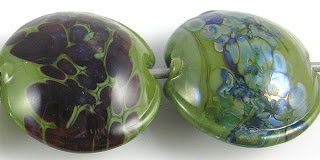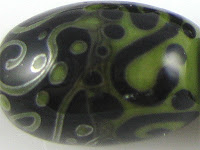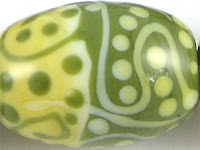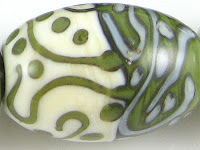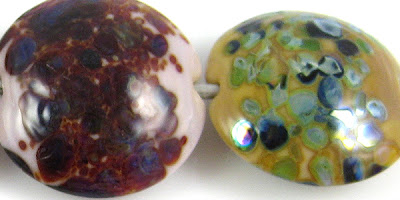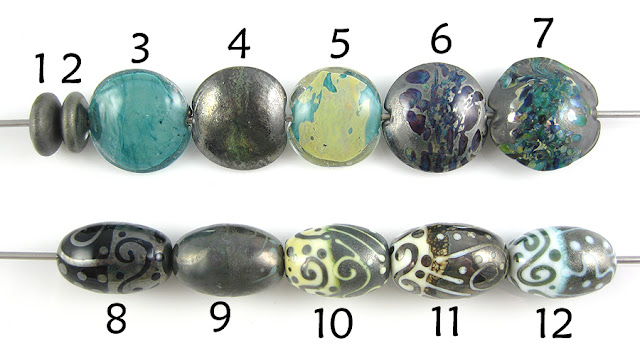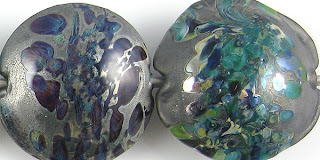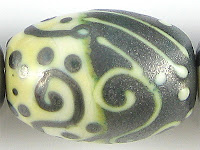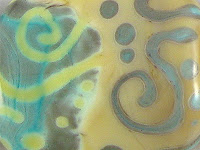CiM Olive is the second glass by the name 'Olive' that I have tested now, and the third that I am aware of. We can hope that it's the last one and that other manufacturers, seeing that there are already three (or more) glasses by this name, will choose some other thing when and if they move ahead with plans for another olive green-coloured glass. Don't get me wrong... I welcome any and all colours to the 104 COE palette. Even when they are named the same thing, they are all deliciously different and interesting to play with. It's just confusing to talk about them when one name could reference multiple different actual colours.
Olive is darker and 'greener' than what I would normally think of when picturing olives, and reminds me more of the colour of the frogs we used to catch when I was a kid when my parents would take us camping. For that reason, I would have named this particular glass 'Kermit' or 'Tadpole' or something else frog-related had it been left up to me.
1 - Plain, 2 - Plain (reduced), 3 - w/ Silver Leaf, 4 - w/ Silver Leaf (reduced & encased), 5 - w/ TerraNova2 Frit, 6 - w/ Silver Glass Frit (reduced), 7 - w/ Tuxedo, 8 - w/ Copper Green, 9 - w/ Opal Yellow, 10 - w/ Ivory, 11 - w/ Peace
So... all whining about the name aside, CiM Olive is a gorgeous green. It's got a unique texture to it, being very smooth and streaky at the same time. It is also, for lack of a better word, somewhat more gelatinous than the other opaque CiM colours and way less 'grainy' than some of the Effetre greens (e.g. Pea Green, Nile Green, Grass Green). Used in a thin layer over Peace, it lightens in colour significantly. Because it is a little less saturated than some of the other greens, it gives an interesting effect when used as the core of vine twisties and canes, lending a bit of an inner glow. Cane made by using a thin layer of Olive over a thick base of Clear gives an interestingly semi-opaque result.
Silver leaf melted into the surface of Olive leaves a greyish/brownish residue behind. The silver discolours slightly, ranging from grey to a blueish tinted grey to a yellowish/brown. In the bead on the right, you can see that when the silver is subsequently reduced and encased that it seems to form an ethereal film over the Olive, and retains some of the blueishness (new word!) but otherwise does not much change the Olive underneath.
My TerraNova2 frit didn't strike very well in the bead on the left, but I think that was my fault. The thin green halos that have sprung up around it are a bit of a clue that Olive is capable of greater things with silver glass frit than I was able to coax from it in this particular bead. In the bead on the right, the reducing silver glass also has an interesting curdling effect on the Olive where it touches the base colour and has thinned out in weird and wonderful ways.
When used on top of CiM Tuxedo, Olive develops a thin silvery line around itself in dots and stringer work. When Tuxedo is used on top of Olive, a greyish green halo pops up around it. This is a very interesting set of reactions for a couple of reasons.
First, Tuxedo bleeds with a lot of the other greens I've tried it with, so it is very refreshing for Olive to be a green that it does not bleed into. Second, a lot of the colours I have tested with Tuxedo recently have had this silver halo effect, but this is the first time I've gotten this reaction between Tuxedo and a green.
Olive makes Copper Green not want to be green at all. The darkness of the Copper Green here is very out of character, and the interesting brownish mottling in the centre of the bead is an effect I've not seen before. Where I've used Copper Green over Olive, it seems to have caused a little curdling chaos in the Olive underneath.
Opal Yellow and Olive do not have any noticeable reaction apart from (possibly) a minor amount of bleeding of the Olive into the Opal Yellow when Olive us used on top of it. You can make out a faint greenish halo around the Olive dots and stringer lines in the left side of this bead if you click on the picture to see an enlarged version of it.
With Ivory, Olive develops an interesting, irregular brownish dark line reaction. It does this both when Ivory is used on top of it and when it is used on top of Ivory. The reaction when Ivory is used on top of Olive is the more dramatic of the two.
Peace and Olive do not have much of a reaction with one another, but it is very interesting to me how much lighter the Olive looks on top of Peace than it does on top of any other colour. The Peace on the left-hand side of the bead seems to have acquired some of the colour from the Olive without leaving any noticeable evidence of 'bleeding'.
I let one of my friends walk off with what was left of my Olive before I'd made many beads with it, and all I've used it in so far is vine cane. That vine cane is attached to beads I'm not ready to show anyone yet, so I"ll end this here.


